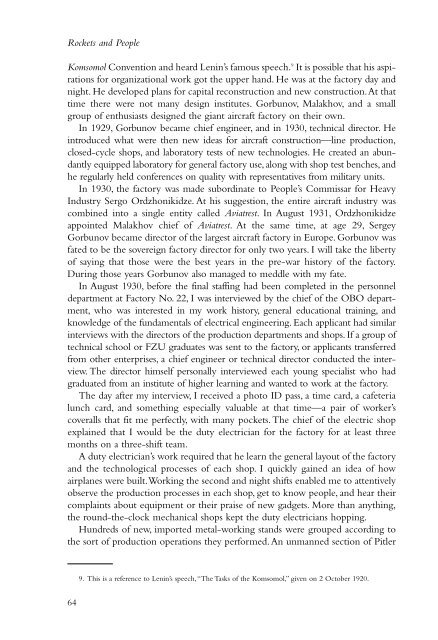to open next chapter. - NASA's History Office
to open next chapter. - NASA's History Office
to open next chapter. - NASA's History Office
Create successful ePaper yourself
Turn your PDF publications into a flip-book with our unique Google optimized e-Paper software.
Rockets and People<br />
Komsomol Convention and heard Lenin’s famous speech. 9 It is possible that his aspirations<br />
for organizational work got the upper hand. He was at the fac<strong>to</strong>ry day and<br />
night. He developed plans for capital reconstruction and new construction.At that<br />
time there were not many design institutes. Gorbunov, Malakhov, and a small<br />
group of enthusiasts designed the giant aircraft fac<strong>to</strong>ry on their own.<br />
In 1929, Gorbunov became chief engineer, and in 1930, technical direc<strong>to</strong>r. He<br />
introduced what were then new ideas for aircraft construction—line production,<br />
closed-cycle shops, and labora<strong>to</strong>ry tests of new technologies. He created an abundantly<br />
equipped labora<strong>to</strong>ry for general fac<strong>to</strong>ry use, along with shop test benches, and<br />
he regularly held conferences on quality with representatives from military units.<br />
In 1930, the fac<strong>to</strong>ry was made subordinate <strong>to</strong> People’s Commissar for Heavy<br />
Industry Sergo Ordzhonikidze. At his suggestion, the entire aircraft industry was<br />
combined in<strong>to</strong> a single entity called Aviatrest. In August 1931, Ordzhonikidze<br />
appointed Malakhov chief of Aviatrest. At the same time, at age 29, Sergey<br />
Gorbunov became direc<strong>to</strong>r of the largest aircraft fac<strong>to</strong>ry in Europe. Gorbunov was<br />
fated <strong>to</strong> be the sovereign fac<strong>to</strong>ry direc<strong>to</strong>r for only two years. I will take the liberty<br />
of saying that those were the best years in the pre-war his<strong>to</strong>ry of the fac<strong>to</strong>ry.<br />
During those years Gorbunov also managed <strong>to</strong> meddle with my fate.<br />
In August 1930, before the final staffing had been completed in the personnel<br />
department at Fac<strong>to</strong>ry No. 22, I was interviewed by the chief of the OBO department,<br />
who was interested in my work his<strong>to</strong>ry, general educational training, and<br />
knowledge of the fundamentals of electrical engineering. Each applicant had similar<br />
interviews with the direc<strong>to</strong>rs of the production departments and shops. If a group of<br />
technical school or FZU graduates was sent <strong>to</strong> the fac<strong>to</strong>ry, or applicants transferred<br />
from other enterprises, a chief engineer or technical direc<strong>to</strong>r conducted the interview.<br />
The direc<strong>to</strong>r himself personally interviewed each young specialist who had<br />
graduated from an institute of higher learning and wanted <strong>to</strong> work at the fac<strong>to</strong>ry.<br />
The day after my interview, I received a pho<strong>to</strong> ID pass, a time card, a cafeteria<br />
lunch card, and something especially valuable at that time—a pair of worker’s<br />
coveralls that fit me perfectly, with many pockets. The chief of the electric shop<br />
explained that I would be the duty electrician for the fac<strong>to</strong>ry for at least three<br />
months on a three-shift team.<br />
A duty electrician’s work required that he learn the general layout of the fac<strong>to</strong>ry<br />
and the technological processes of each shop. I quickly gained an idea of how<br />
airplanes were built.Working the second and night shifts enabled me <strong>to</strong> attentively<br />
observe the production processes in each shop, get <strong>to</strong> know people, and hear their<br />
complaints about equipment or their praise of new gadgets. More than anything,<br />
the round-the-clock mechanical shops kept the duty electricians hopping.<br />
Hundreds of new, imported metal-working stands were grouped according <strong>to</strong><br />
the sort of production operations they performed.An unmanned section of Pitler<br />
64<br />
9. This is a reference <strong>to</strong> Lenin’s speech,“The Tasks of the Komsomol,” given on 2 Oc<strong>to</strong>ber 1920.
















